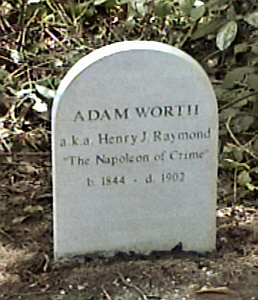 Famously nicknamed "The Napoleon of the criminal world" by Scotland Yard's Robert Anderson, Adam Worth is widely rumoured to be the blueprint of Sir Arthur Conan Doyle's criminal mastermind Professor Moriarty.
Famously nicknamed "The Napoleon of the criminal world" by Scotland Yard's Robert Anderson, Adam Worth is widely rumoured to be the blueprint of Sir Arthur Conan Doyle's criminal mastermind Professor Moriarty. Born to a poor Jewish family in the present day Germany, his parents moved to Cambridge, Massachusetts where his father became a tailor. Enticed by greater prospects, he ran away at an early age, first to Boston and then eventually to New York City. At the outbreak of the American Civil War he enlisted, lying about his age (17) to join the Union army. Similar to many other successful criminals, he demonstrated a level of competence during battle and was promoted a number of times. This would prove to be a turning point in his life.
A wound during the second Battle of Bull Run redirected him to Georgetown Hospital Washington D.C. where he would soon discover that a paperwork mix-up listed him as "killed in action". Shedding his old life, he would use this opportunity to recreate his identity.
The chameleon
Slipping through the cracks, Worth assumed a number of names, collecting cheques by enlisting in various regiments and then deserting. When the Pinkerton Detective Agency began to sniff around he soon fled, returning to safety in New York City. Pickpocketing, small heists, robberies and even tunnelling a break-in to a jail to help a safecracker Charley Bullard escape, would catapult Worth into the big leagues. In November 20, 1869, Worth robbed the vault of the Boylston National Bank in Boston with his newly freed accomplice Bullard.
Europe
With Pinkerton alerted by the bank, Worth and Bullard decided to relocate to Liverpool under the alias "Henry Judson Raymond", a financier and "Charles H. Wells", a Texas oilman respectively. Joined by a barmaid Kitty Flynn (who would later marry Bullard) they would continue their criminal activities with small robberies until their move to Paris in 1871. Opening an "American Bar", it would front as a legitimate business masking their gambling den on the upper floor. The American Detective Agency still hot on their trail would eventually find them, but fortunately Worth recognized Allan Pinkerton and they eventually abandoned their restaurant.
In London, Worth and his associates (some from his New York days) purchased West Lodge, blending into the circles of high society. It would be here that his schemes developed into mastery. Forming a criminal web of large scale organized heists through intermediaries, he cleverly managed to keep his identity unknown while devising each intricate theft. To the frustration of the Scotland Yard no one could prove anything substantial for quite a few years.
Nothing lasts forever...
Things began to unravel when Worth's brother John was caught cashing a forged cheque in Paris, and four of his associates were arrested in Constantinople. Spending great sums of money to free his brother and accomplices, exposure was only a matter of time. However it would be Bullard's unstable behaviour from his alcoholism that would signal the crumbling relationship of the group, his eventual departure for New York was quickly followed by his wife Kitty.
One his most famous robberies was the Thomas Gainsborough painting of Georgiana Cavendish, Duchess of Devonshire from the London gallery. An acquisition that he never attempted to sell, and that he would keep with him for many years afterwards.
Unlike Professor Moriarty however, Worth was essentially human in nature. Perhaps this was his Achillies heel. Not only did he marry (her identity has never been known) but he would have children under the alias name Henry Raymond. Disgruntled associates (Junka Phillips and Little Joe), a weakness for new challenges (theft of $500,000 uncut diamonds), and loyalty to old friends would eventually give him away to the authorities.
Capture

In 1892 Worth visited Belgium where Bullard was said to be imprisoned with Worth's great rival Max Shinburn. On October 5 Worth improvised a robbery with two untried associates which would go awry. Captured red handed, the other two escaped leaving Worth at the mercy of the Belgian police. Despite his denial of all charges, the New York Police department and Scotland Yard identified him leading to his sentence of seven years with the added statements from his nemesis, Max Shinburn.
In 1897 Worth was released for good behaviour and he would return to London, stealing £4,000 from a diamond shop (a leopard doesn't change his spots!) and return to his wife. During his incarceration Worth discovered that his previous associate Johnny Curtin had seduced and abandoned his wife, pushing her into mental hysteria and committal into an asylum, she barely recognized him. Returning to New York where his children were under the care of his brother, he would detail his exploits to William Pinkerton, the Detective Agency that sought his capture for so many years. He finally arranged the return of the painting of the Duchess of Devonshire to Agnew & Sons for the price of $25,000. He spent his remaining years in London with this children, and strangely enough his son would become a Pinkerton detective.
He was buried in Highgate Cemetery after his death on January 8, 1902 under the pauper's grave as "Henry J. Raymond".